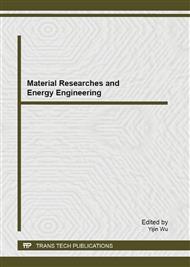[1]
R. Cajka: Static reinforcement of existing timber ceiling (2011). Registered Utility model No. U1 22590, Industrial Property Office, Czech Republic, Prague, August (2011).
Google Scholar
[2]
R. Cajka: Soil – structure interaction in case of exceptional mining and flood actions (2005). COST 12 – Final Conference Proceedings, 20th – 22nd January 2005, University of Innsbruck, Austria, ISBN 04 1536 609 7.
DOI: 10.1201/9780203970843.ch41
Google Scholar
[3]
V. Frankova and V. Mencl: Estimation of properties of materials for compound wood – timber ceilings (2007). Diploma thesis, Faculty of Civil Engineering, VŠB – TU Ostrava, (2007).
Google Scholar
[4]
P. Janas, M. Krejsa and V. Krejsa: Structural reliability assessment using a direct determined probabilistic calculation (2009).
DOI: 10.4203/ccp.91.72
Google Scholar
[5]
P. Kucera, A. Lokaj and D. Kacikova: Assessment of reliability of timber structures elements exposed large-scale fire test (2012). Acta Facultatis Xylologiae, 54 (1), pp.95-104, ISSN 13363824.
Google Scholar
[6]
P. Kuklik, P. Nechanicky and A. Kuklikova: Development of prefabricated timber-concrete composite floors (2012). World Conference on Timber Engineering 2012, WCTE 2012, pp.519-526. ISBN: 978-162276305-4.
Google Scholar
[7]
A. Lokaj, K. Vavrusova and E. Rykalova: Application of laboratory tests results of dowel joints in cement-splinter boards VELOX into the fully probabilistic methods (SBRA method) (2012).
DOI: 10.4028/www.scientific.net/amm.137.95
Google Scholar
[8]
D. Mikolasek and O. Sucharda: Numerical modelling of a composite timber-concrete floor structure (2012). Civil Engineering Journal 9/2012, p.272 – 276, ISSN 1805-2576 (Online), ISSN 1210-4027 (Print).
Google Scholar
[9]
J. Postulka and J. Sandanus: Berechnungsverfahren für eine Holz-Beton-Verbunddecke mit nägeln als verbindungsmittel (1999). Bautechnik, 76(11), pp.1026-1030, ISSN 09328351.
DOI: 10.1002/bate.199906470
Google Scholar
[10]
J. Sandanus: Parametric study of the factors affecting the resistance of a composite timber-concrete cross-section (2007). Wood Research, vol. 52, no. 3, pp.109-114. ISSN 13364561.
Google Scholar
[11]
K. Vavrusova, A. Lokaj and L. Zidek: Reliance of embedment strength on dowel diameter in joints of cement-splinter boards (2012).
DOI: 10.4028/www.scientific.net/amm.188.242
Google Scholar
[12]
K. Vavrusova, A. Lokaj and L. Zidek: The bearing capacity of one-shear nail joints in cement-splinter boards (2013).
DOI: 10.4028/www.scientific.net/amm.256-259.901
Google Scholar


